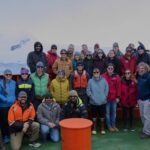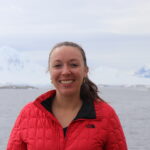Blooming Antarctica
story by Helen Hill for MITgcm
The Southern Ocean plays a critical role in the global carbon cycle by acting as a major sink for CO2. In particular, coastal regions around Antarctica can be understood to play an outsize role, with high biological productivity there having the potential to act as a particularly strong sink for anthropogenic carbon. However, large-scale air-sea CO2 flux estimates for Antarctic coastal regions are confounded by limited data coverage, calling for modeling studies to help improve researchers’ understanding of the air-sea flux and biological carbon cycling that can happen there.
To that end, Cristina Schultz, while a postdoc in Scott Doney’s Computational Biogeochemical Lab at the University of Virginia’s Department of Environmental Science used an ocean circulation, sea-ice, and biogeochemistry model of the West Antarctic Peninsula (WAP) to study how the cycle of sea-ice affects cycles in phytoplankton and surface dissolved inorganic carbon (DIC) there. A preprint of the paper to come out of her study, co-authored with Doney, Judith Hauck (Alfred Wegener Institute), Maria Kavanaugh (Oregon State University), and Oscar Schofield (Rutgers), was recently accepted for publication in the Journal of Geophysical Research – Biogeosciences.
Full article at MITgcm



 This site was developed with the support of the National Science Foundation under Grant No. OPP-2224611 and OPP-2026045. Any opinions, findings, and conclusions or recommendations expressed in this material are those of the authors and do not necessarily reflect the views of the National Science Foundation.
This site was developed with the support of the National Science Foundation under Grant No. OPP-2224611 and OPP-2026045. Any opinions, findings, and conclusions or recommendations expressed in this material are those of the authors and do not necessarily reflect the views of the National Science Foundation.
